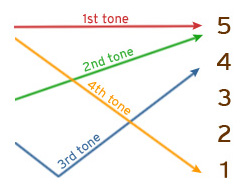
Learning tones in Chinese is a fundamental part of studying the language, but something people are often too quick to categorise as non-essential when starting out, when being understood and making quick progress are the priorities.
From my own experience, I neglected tones when speaking and stroke order when writing for years into my study of Chinese, both of which came back to bite me when I entered further education. I would always advise that, although painful and at times tedious, dedicating the extra time to studying tones and stroke order are essential when you start learning Mandarin, as it will only ever benefit you going forward.
What are the tones in Chinese?
Mandarin is a tonal language, which means words can be pronounced in a different pitch. People always use the example of “ma”, which can mean mother, spicy, horse, the verb to yell, and a particle used to ask a question. Confusing, right? Well, not if you get an early grasp on them.
There are five different tones in Mandarin. When displayed, each tone is indicated with a separate tonal marker to indicate tone of voice. The fifth, “neutral” tone, is not marked with a tonal marker.
First Tone
The first tone is high and flat and can be longer in sound than the other tones.
Second Tone
The second tone is rising.
Third Tone
Often called “falling-rising”, but in fact it starts low, falls slightly and rises to the previous low.
Fourth Tone
A shorter, falling tone, that can come across as abrupt.
Fifth, “Neutral” Tone
Soft and light, to be pronounced softly and with the lack of any tonal changes.
Chinese Names for the Tones
You can listen out in class for your teacher calling out the tones by the following names:
First tone: 第一声// dì yì shēng
Second tone: 第二声 // dì èr shēng
Third tone: 第三声 // dì sān shēng
Fourth tone: 第四声 // dì sì shēng
What’s the Best Way to Learn Tones in Chinese?
- Learn the way that each tone sounds.
- Practice using the tones with words you already know in Chinese. You can use tools such as Google Speech-to-Text to test how accurate you are in the absence of a teacher/Chinese friend to practice with.
- Get a language partner or teacher to help you, if you have the means to do so. Ask them to correct your tones when they aren’t correct.
- Listen out to Chinese speakers for indications of tones in the words they are saying. It can help to mimic the speech of a native speaker to pick up tones in a “natural” way. Note: tones are often missed out when singing in Chinese, so don’t follow tones on words you hear in songs.
- Keep at it! Don’t give up because it becomes frustrating or tedious and develop a consistent approach to reach your goals of speaking with the correct tones in Chinese.
Remember that you can use the Live Dictionary in each TCB lesson to hear the tones of any character or word, as well as the full spoken lesson audio to hear the passage in full.
Don’t neglect those tones!

















